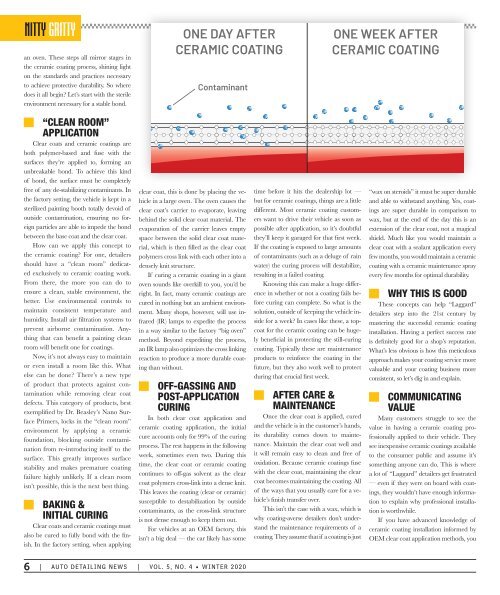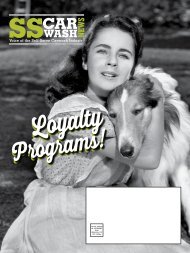Auto Detailing News Winter issue
You also want an ePaper? Increase the reach of your titles
YUMPU automatically turns print PDFs into web optimized ePapers that Google loves.
NITTY GRITTY<br />
an oven. These steps all mirror stages in<br />
the ceramic coating process, shining light<br />
on the standards and practices necessary<br />
to achieve protective durability. So where<br />
does it all begin? Let’s start with the sterile<br />
environment necessary for a stable bond.<br />
ONE DAY AFTER<br />
CERAMIC COATING<br />
Contaminant<br />
ONE WEEK AFTER<br />
CERAMIC COATING<br />
“CLEAN ROOM”<br />
APPLICATION<br />
Clear coats and ceramic coatings are<br />
both polymer-based and fuse with the<br />
surfaces they’re applied to, forming an<br />
unbreakable bond. To achieve this kind<br />
of bond, the surface must be completely<br />
free of any de-stabilizing contaminants. In<br />
the factory setting, the vehicle is kept in a<br />
sterilized painting booth totally devoid of<br />
outside contamination, ensuring no foreign<br />
particles are able to impede the bond<br />
between the base coat and the clear coat.<br />
How can we apply this concept to<br />
the ceramic coating? For one, detailers<br />
should have a “clean room” dedicated<br />
exclusively to ceramic coating work.<br />
From there, the more you can do to<br />
ensure a clean, stable environment, the<br />
better. Use environmental controls to<br />
maintain consistent temperature and<br />
humidity. Install air filtration systems to<br />
prevent airborne contamination. Anything<br />
that can benefit a painting clean<br />
room will benefit one for coatings.<br />
Now, it’s not always easy to maintain<br />
or even install a room like this. What<br />
else can be done? There’s a new type<br />
of product that protects against contamination<br />
while removing clear coat<br />
defects. This category of products, best<br />
exemplified by Dr. Beasley’s Nano Surface<br />
Primers, locks in the “clean room”<br />
environment by applying a ceramic<br />
foundation, blocking outside contamination<br />
from re-introducing itself to the<br />
surface. This greatly improves surface<br />
stability and makes premature coating<br />
failure highly unlikely. If a clean room<br />
isn’t possible, this is the next best thing.<br />
BAKING &<br />
INITIAL CURING<br />
Clear coats and ceramic coatings must<br />
also be cured to fully bond with the finish.<br />
In the factory setting, when applying<br />
clear coat, this is done by placing the vehicle<br />
in a large oven. The oven causes the<br />
clear coat’s carrier to evaporate, leaving<br />
behind the solid clear coat material. The<br />
evaporation of the carrier leaves empty<br />
space between the solid clear coat material,<br />
which is then filled as the clear coat<br />
polymers cross link with each other into a<br />
densely knit structure.<br />
If curing a ceramic coating in a giant<br />
oven sounds like overkill to you, you’d be<br />
right. In fact, many ceramic coatings are<br />
cured in nothing but an ambient environment.<br />
Many shops, however, will use infrared<br />
(IR) lamps to expedite the process<br />
in a way similar to the factory “big oven”<br />
method. Beyond expediting the process,<br />
an IR lamp also optimizes the cross linking<br />
reaction to produce a more durable coating<br />
than without.<br />
OFF-GASSING AND<br />
POST-APPLICATION<br />
CURING<br />
In both clear coat application and<br />
ceramic coating application, the initial<br />
cure accounts only for 99% of the curing<br />
process. The rest happens in the following<br />
week, sometimes even two. During this<br />
time, the clear coat or ceramic coating<br />
continues to off-gas solvent as the clear<br />
coat polymers cross-link into a dense knit.<br />
This leaves the coating (clear or ceramic)<br />
susceptible to destabilization by outside<br />
contaminants, as the cross-link structure<br />
is not dense enough to keep them out.<br />
For vehicles at an OEM factory, this<br />
isn’t a big deal — the car likely has some<br />
time before it hits the dealership lot —<br />
but for ceramic coatings, things are a little<br />
different. Most ceramic coating customers<br />
want to drive their vehicle as soon as<br />
possible after application, so it’s doubtful<br />
they’ll keep it garaged for that first week.<br />
If the coating is exposed to large amounts<br />
of contaminants (such as a deluge of rain<br />
water) the curing process will destabilize,<br />
resulting in a failed coating.<br />
Knowing this can make a huge difference<br />
in whether or not a coating fails before<br />
curing can complete. So what is the<br />
solution, outside of keeping the vehicle inside<br />
for a week? In cases like these, a topcoat<br />
for the ceramic coating can be hugely<br />
beneficial in protecting the still-curing<br />
coating. Typically these are maintenance<br />
products to reinforce the coating in the<br />
future, but they also work well to protect<br />
during that crucial first week.<br />
AFTER CARE &<br />
MAINTENANCE<br />
Once the clear coat is applied, cured<br />
and the vehicle is in the customer’s hands,<br />
its durability comes down to maintenance.<br />
Maintain the clear coat well and<br />
it will remain easy to clean and free of<br />
oxidation. Because ceramic coatings fuse<br />
with the clear coat, maintaining the clear<br />
coat becomes maintaining the coating. All<br />
of the ways that you usually care for a vehicle’s<br />
finish transfer over.<br />
This isn’t the case with a wax, which is<br />
why coating-averse detailers don’t understand<br />
the maintenance requirements of a<br />
coating. They assume that if a coating is just<br />
“wax on steroids” it must be super durable<br />
and able to withstand anything. Yes, coatings<br />
are super durable in comparison to<br />
wax, but at the end of the day this is an<br />
extension of the clear coat, not a magical<br />
shield. Much like you would maintain a<br />
clear coat with a sealant application every<br />
few months, you would maintain a ceramic<br />
coating with a ceramic maintenance spray<br />
every few months for optimal durability.<br />
WHY THIS IS GOOD<br />
These concepts can help “Laggard”<br />
detailers step into the 21st century by<br />
mastering the successful ceramic coating<br />
installation. Having a perfect success rate<br />
is definitely good for a shop’s reputation.<br />
What’s less obvious is how this meticulous<br />
approach makes your coating service more<br />
valuable and your coating business more<br />
consistent, so let’s dig in and explain.<br />
COMMUNICATING<br />
VALUE<br />
Many customers struggle to see the<br />
value in having a ceramic coating professionally<br />
applied to their vehicle. They<br />
see inexpensive ceramic coatings available<br />
to the consumer public and assume it’s<br />
something anyone can do. This is where<br />
a lot of “Laggard” detailers get frustrated<br />
— even if they were on board with coatings,<br />
they wouldn’t have enough information<br />
to explain why professional installation<br />
is worthwhile.<br />
If you have advanced knowledge of<br />
ceramic coating installation informed by<br />
OEM clear coat application methods, you<br />
6 | AUTO DETAILING NEWS | VOL. 5, NO. 4 • WINTER 2020

















